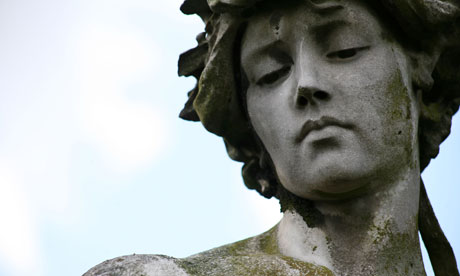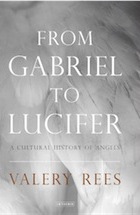From Gabriel to Lucifer: A Cultural History of Angels by Valery Rees
Tom Holland has an encounter with the heavenly host

Photograph: Alamy
Last year, I interviewed an Israeli veteran of the six-day war who claimed to have met an angel. During the battle for the Golan Heights, a Syrian shell had sent him flying from his tank. As he lay wounded and immobile on the ground, he saw enemy soldiers advancing towards him. They raised their guns. Then, abruptly, a golden figure appeared. The Israeli had been chosen, so the mysterious figure informed him, for an awesome mission. God wished him to rebuild the Temple in Jerusalem. Then all went black.
When the Israeli recovered consciousness, he found himself safe and sound in hospital. Soon afterwards, he was visited by UN inspectors. As he related his experience, they stared at him in astonishment. A few days earlier, they revealed, they had been interviewing a group of Syrian soldiers – and these had spoken of a golden figure that had miraculously appeared between them and an injured Israeli, and put them to flight. Proof enough, so my interviewee assured me, that an angel had indeed appeared in the field of battle to save him that day.
Nor was that the last he had seen of angels. We met for the interview on the Mount of Olives, directly opposite the massive esplanade on which any future Temple would be built. Every so often, my interviewee would turn towards it, a look of yearning on his face. He had seen the feathers of golden wings, he told me, brushing the surface of the holy rock. The site where once an angel had spoken to Abraham, and the cherubim-guarded Ark of the Covenant been housed back in the days of Solomon, remained to this day under the watch of angels.
Except that 40 years and more had passed since the six-day war, and still my interviewee had failed to complete his mission. Angelic backing or not, he faced a seemingly insuperable problem. The site was already occupied. Anyone wishing to rebuild the Temple would first have to demolish the Dome of the Rock, the first and perhaps the most beautiful of all Islamic buildings. Jews, after all, are not the only people to believe in angels. So too do Muslims. The Dome of the Rock, so Muslim tradition teaches, was built to commemorate the miraculous night journey taken by Muhammad prior to his ascension through the heavens, when he was brought from Mecca to Jerusalem by Jibra'il, the angel known in the Bible as Gabriel.
Even in the 21st century, then, angels matter. To many of us, perhaps, this can come as a surprise. Here in Britain, the ebbing of religious faith has combined with our insatiable taste for kitsch to desensitise us to the historic potency of angelology. Yet the ubiquity of angels in pop songs, on Christmas cards and in episodes of Dr Who tells its own story. "In our increasingly secular age, when the presence of angelic beings seems remote and unreal, angel imagery still holds an immense power of attraction." So Valery Rees opens her new book, which aims to make sense of the dimension between heaven and earth, and to explain why so many people, for so long, have populated it with entire hosts of messengers.
In pursuit of that goal, Rees flits across space and time with an aptly angelic facility. Ranging from ancient Sumeria to the novels of Philip Pullman, and from medieval scholasticism to Jungian theory, the breadth of her learning is formidable. We are given accounts of the cherubim and seraphim that read almost like the reports of a field anthropologist, detailed biographies of the archangels, and a rich seam of angelological trivia. The next time you are at a carol concert and want to impress someone, why not follow up a rendition of "Hark! The Herald Angels Sing" by revealing that the 15th-century philosopher Marsilio Ficino thought there were 399,920,004 angels in all, that the Qur'an features angels with three wings, and that Pius XII claimed to have seen St Peter's Square thronged with the guardian angels of the faithful gathered below him?
Yet ultimately, the sheer extent of Rees's researches overwhelm her. Perhaps the risk of this happening was inherent in the subject. Angels, after all, are notoriously hard to pin down. "Let no one suppose," Philo of Alexandria declared in the 1st century AD, "that what is here said is a myth." Rees, though, seems unable to decide quite what she thinks. She writes as an eminent scholar of the renaissance, but part of her, as she acknowledges in her epilogue, wants to believe in the literal truth of the angelic realm. As a result, the parameters of her investigation are constantly shifting. Sometimes angels are described as though they possess an objective reality; sometimes as though they are expressions of the subconscious; sometimes as though they are theological constructs.
What Rees does not do, but surely would have profited from doing, is to treat angels as a phenomenon of cultural evolution. Whether real or not, it is certain that different peoples at different times have had very different understandings of them – and that these various differences have often had a dramatic impact on history.
It was a debate about the nature of angels, many scholars now argue, that lay at the heart of the disagreements between Muhammad and his opponents, as recorded in the Qur'an; in medieval Christendom, it was an ambition to emulate the angelic choirs of heaven that repeatedly inspired monastic reform movements and an entire papal revolution; it was a desire to fathom the metaphysics of a Platonic angelology that did much to supercharge the renaissance. In our own day, as the competing ambitions of Jews and Muslims for the Temple Mount demonstrate, angels have not lost their potential to shape the course of events. From Gabriel to Lucifer gives us plenty of culture, but not nearly enough history. As such, it ranks as an opportunity missed.
• Tom Holland's In the Shadow of the Sword is published by Little, Brown.
- Tell us what you think: Star-rate and review this book
Nor was that the last he had seen of angels. We met for the interview on the Mount of Olives, directly opposite the massive esplanade on which any future Temple would be built. Every so often, my interviewee would turn towards it, a look of yearning on his face. He had seen the feathers of golden wings, he told me, brushing the surface of the holy rock. The site where once an angel had spoken to Abraham, and the cherubim-guarded Ark of the Covenant been housed back in the days of Solomon, remained to this day under the watch of angels.
Except that 40 years and more had passed since the six-day war, and still my interviewee had failed to complete his mission. Angelic backing or not, he faced a seemingly insuperable problem. The site was already occupied. Anyone wishing to rebuild the Temple would first have to demolish the Dome of the Rock, the first and perhaps the most beautiful of all Islamic buildings. Jews, after all, are not the only people to believe in angels. So too do Muslims. The Dome of the Rock, so Muslim tradition teaches, was built to commemorate the miraculous night journey taken by Muhammad prior to his ascension through the heavens, when he was brought from Mecca to Jerusalem by Jibra'il, the angel known in the Bible as Gabriel.
In pursuit of that goal, Rees flits across space and time with an aptly angelic facility. Ranging from ancient Sumeria to the novels of Philip Pullman, and from medieval scholasticism to Jungian theory, the breadth of her learning is formidable. We are given accounts of the cherubim and seraphim that read almost like the reports of a field anthropologist, detailed biographies of the archangels, and a rich seam of angelological trivia. The next time you are at a carol concert and want to impress someone, why not follow up a rendition of "Hark! The Herald Angels Sing" by revealing that the 15th-century philosopher Marsilio Ficino thought there were 399,920,004 angels in all, that the Qur'an features angels with three wings, and that Pius XII claimed to have seen St Peter's Square thronged with the guardian angels of the faithful gathered below him?
Yet ultimately, the sheer extent of Rees's researches overwhelm her. Perhaps the risk of this happening was inherent in the subject. Angels, after all, are notoriously hard to pin down. "Let no one suppose," Philo of Alexandria declared in the 1st century AD, "that what is here said is a myth." Rees, though, seems unable to decide quite what she thinks. She writes as an eminent scholar of the renaissance, but part of her, as she acknowledges in her epilogue, wants to believe in the literal truth of the angelic realm. As a result, the parameters of her investigation are constantly shifting. Sometimes angels are described as though they possess an objective reality; sometimes as though they are expressions of the subconscious; sometimes as though they are theological constructs.
What Rees does not do, but surely would have profited from doing, is to treat angels as a phenomenon of cultural evolution. Whether real or not, it is certain that different peoples at different times have had very different understandings of them – and that these various differences have often had a dramatic impact on history.
It was a debate about the nature of angels, many scholars now argue, that lay at the heart of the disagreements between Muhammad and his opponents, as recorded in the Qur'an; in medieval Christendom, it was an ambition to emulate the angelic choirs of heaven that repeatedly inspired monastic reform movements and an entire papal revolution; it was a desire to fathom the metaphysics of a Platonic angelology that did much to supercharge the renaissance. In our own day, as the competing ambitions of Jews and Muslims for the Temple Mount demonstrate, angels have not lost their potential to shape the course of events. From Gabriel to Lucifer gives us plenty of culture, but not nearly enough history. As such, it ranks as an opportunity missed.
• Tom Holland's In the Shadow of the Sword is published by Little, Brown.
